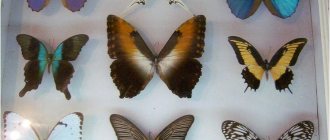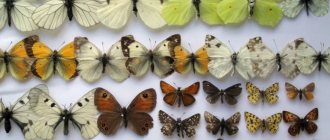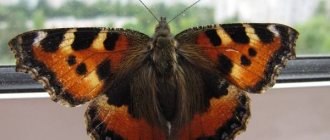Time and place to catch butterflies
We have already mentioned above that for catching butterflies it is most convenient to go on bright, sunny and windless days. As for the places where butterflies are most likely to gather in large numbers, these include fields sown with clover, the edge of a forest dotted with beautiful flowers, vast, beautiful meadows, etc.
As dusk approaches, nocturnal butterflies usually appear; at night, whole flocks of small midges, etc.
To attract more moths to one place, to a tree or bush, their branches are doused with a mixture of honey, water and white beer or sugar water; butterflies, attracted by the smell, gather somewhere on one of the branches, where, with some dexterity, it is not difficult to catch them.
How to catch butterflies?
There are special nets for catching butterflies. The net, supported by a stick, consists of a circle made of strong wire; The diameter of the circle is approximately 30 centimeters. A rather long bag made like a cone from some light material, gas, etc. is attached to the circle.
It is more convenient to make the circle described above from two separate, well-folding halves, each of which is equipped with a quadrant hole at the lower end and secured with a nut. An ordinary stick is driven into a hollow iron cylinder and secured with a side screw.
When he sees insects, the young naturalist carefully approaches, trying to walk in such a direction that the shadow he casts is placed behind him and not in front - otherwise, the approaching shadow will frighten the insects and they will quickly fly away.
At some distance from the insect, the boy deftly throws a net over it, making several movements with it from side to side, due to which it surrounds the insect so much that it is not possible for him to escape from the net.
In addition to the mesh, you also need to stock up on scissors of a special device, which consist of a handle made of strong iron wire, and legs representing frames, approximately quadrangular or round in shape, also made of iron wire and covered with gas (gauze). Both frames differ in size, so that when the scissors are closed, the larger frame encloses the smaller one - thanks to this special device, the captured insect is firmly held.
What you will need
- A jar with a screw cap for stain (for example, mayonnaise).
- Light paper (any clean paper that doesn’t get dirty) for stuffing stain and making mattresses.
- Thick paper for labels and mattresses.
- Nail polish remover as a poison ( pure ethyl acetate ).
- An old badminton racket to make a net out of. You can also make a classic type net - from thick wire and a wooden stick.
- Translucent fabric (gas) or strong mesh to sew the net bag. You can use regular gauze, but it won't last long, especially if it gets wet.
- Thread and needle.
- Cotton wool for mattresses.
- Cardboard boxes (for example, sugar boxes) for mattresses.
- Entomological pins (you can buy them, for example, at https://www.entomon.ru/online/). It is important to use entomological pins of standard length with comfortable round heads. Others are often short-lived (they rust quickly), difficult to handle, and too long or short.
- Plastic containers for boxes (large metal candy boxes work too).
- Polyurethane foam mat (“foam”) on the bottom of the boxes.
- Glue for plastic (for example, “Moment”).
- Magnifier or binocular microscope (binocular).
Butterfly collection
Each board is equipped with a piece of paper glued with gum arabic, on which the belonging of the butterfly to one or another species is indicated. To determine the species, genus of butterflies, etc. They usually use some kind of natural history textbook that is understandable to children.
Collections are stored in boxes approximately 20-25 centimeters wide, 30-40 centimeters long, and about 6 centimeters high.
Having carefully placed the collections in the box, it is covered with a sliding wooden or glass lid. A cork of known thickness or peat is placed at the bottom of the box so that pins can be inserted freely.
It is most convenient to prick butterflies in a certain order from top to bottom; Before closing the box, a small vial filled with gasoline is placed in it, which protects them from moths and beetles. Instead of a bottle of gasoline, you can also put a few grains of camphor in the box.
In the case when the wings of the butterfly become wrinkled again from time to time, the butterfly is again placed on damp sand under a glass cover and then, when the wings become soft and flexible again, they are carefully straightened. When mold appears in the box, the corresponding place is lubricated with a brush dipped in alcohol or ether.
What is the best time to catch insects?
The best time for catching insects is usually May and June - only some types of insects can be caught by the end of summer. More convenient hours of the day, if you have a choice, should be considered the afternoon, because most insects usually fly in the hottest hours of the day, when the sun's rays are most warm; some of them, for example, a famous species of moths, hide together with the sunset. Nocturnal insects are usually caught at dusk and in the evening. Insects are especially easy to catch before a thunderstorm; the stuffy air sets them in motion and they crawl out of their homes.
How to collect beetles
Collecting beetles is unlikely to differ in any significant way from collecting butterflies. Beetles are found especially often in vegetable gardens, meadows, etc.; They are usually caught with a bag called a scoop. The latter consists of a stick equipped at one end with a wire circle, to which is attached a bag made of coarse linen. The scoop, with the hole pointing downwards, is moved across the grass, bushes, etc., capturing any insects that come across in a bag.
There is another device for catching beetles, the so-called mace, arranged as follows: a stone of quite significant weight, or a weight weighing 2 pounds, is carefully wrapped in rags and covered with cloth or leather, after which a belt is attached to it accordingly or rope.
With such a mace, children go to catch beetles - approaching a tree, they spread a scarf under it and hit the tree trunk with a certain force with the mace. The blow causes the tree to shake, and beetles, caterpillars, etc., which have found shelter in various corners of the tree, fall on the scarf in abundance.
The method of catching beetles just described is especially practiced in places where deciduous trees grow.
In the early morning hours, when a mace strikes such a deciduous tree, heaps of insects usually fall to the ground. Some types of beetles are found in ant nests, so when going after them, you need to carefully inspect the anthills.











